이 시점에서 우리 모두는 야채를 식단에 포함시키는 것이 중요하다는 것을 알고 있습니다. 사실, 이들은 아마도 가장 중요한 식품군 중 하나일 것이며, 전 세계 영양학자들은 이를 우리 식단의 가장 큰 부분으로 만들어야 한다는 점을 강조합니다.
육류나 가공식품에 비해 엄청나게 저렴할 뿐만 아니라, 저탄수화물 식품이기도 합니다!
그것은 우리의 건강에 환상적이며, 다양한 비타민 미네랄이 풍부하고 섬유질의 훌륭한 공급원이기도 합니다.
하지만 많은 사람들은 항상 어떤 야채를 먹어야 할지 고민합니다. 슈퍼마켓의 야채 코너를 걸어가면 꽤 압도적일 수 있습니다!
여러분 모두가 좀 더 쉽게 슈퍼마켓을 방문할 수 있도록 영양학적으로 더욱 성공적인 슈퍼마켓 방문을 위해 가장 건강한 야채 10가지 목록을 정리했습니다.
브로콜리
바미 브로콜리
십자화과 야채 계열에 속하는 브로콜리는 전 세계 요리에서 찾아볼 수 있습니다.
야채 중 가장 흔히 먹는 부분은 머리라고 불리는 식물의 꽃 부분입니다.
두툼한 줄기를 머리에서 분리한 후 버리는 사람들도 있지만 실제로는 먹을 수도 있고 영양가도 높습니다!
생 브로콜리 한 컵(3.2oz/91g)에는 다음과 같은 영양소가 풍부합니다.
비타민C 일일 필요량 135%
일일 필수 비타민 K의 116%
일일 필요량의 10% 섬유질, 엽산, 망간, 비타민 A
또한 브로콜리를 먹으면 암 위험을 줄이고 신체의 산화제를 낮추는 데 도움이 될 수 있다고 주장됩니다!
브뤼셀 콩나물
공 같은 브뤼셀
브뤼셀 콩나물은 매우 유익한 십자화과 야채과의 또 다른 구성원입니다.
하지만 이 야채는 식탁에서 훨씬 더 많은 이야기를 담고 있습니다.
전 세계 어린이들은 아마도 최악의 야채라고 생각하지만, 어른이 되어서는 맛있으면서도 영양가 있는 자연에 감탄하게 됩니다!
생 브뤼셀 콩나물 한 컵(3.1oz/88g)에는 다음과 같은 성분이 들어있습니다.
비타민K 일일 필요량 195%
비타민C 일일 필요량 125%
일일 필수 비타민 B6, 엽산, 칼륨, 섬유질의 최소 10%
브로콜리와 마찬가지로 브뤼셀 콩나물에는 많은 건강상의 이점이 있습니다. 특히, 캠페롤이라는 항산화제가 함유되어 있습니다.
이는 신체의 해독에 도움이 되며, 세포 손상을 예방하는데도 도움이 된다고 합니다!
시금치
슈퍼 시금치
시금치는 단순히 잎채소라고 불리는 더 넓은 범주의 야채에 속합니다.
많은 사람들이 먹을 수 있는 가장 건강에 좋은 야채 중 하나로 언급되는 이 야채는 확실히 실망스럽지 않습니다!
어린 시금치는 종종 생으로 먹지만, 다 자란 시금치는 다른 재료와 함께 요리하는 경우가 가장 많습니다.
잘게 썬 생 시금치 한 컵(1.1oz/30g)은 다음을 함유하고 있어 샐러드에 단순히 맛있는 첨가물이 아닙니다.
7칼로리에 불과하다
비타민A 일일 필요량의 56%
비타민K 일일 필요량 181%
소량의 건강한 다양한 망간, 비타민 C 및 엽산.
시금치는 또한 만성 질환의 위험을 줄이는 데 도움이 되는 다양한 항산화제가 풍부합니다.
이러한 항산화제 중 두 가지는 루테인과 베타카로틴으로 암 위험을 줄이는 것과도 관련이 있습니다.
케일
곱슬 케일
또 다른 인기 있는 잎이 많은 녹색 채소는 케일입니다.
케일은 건강식품 트렌드 덕분에 2010년대 초반에 명성을 얻었지만 반응은 상당히 양극화되었습니다. 사람들은 그것을 좋아하거나 맛을 참을 수 없었습니다!
하지만 케일의 영양학적 이점을 고려하면 케일이 그토록 큰 성장을 이룬 것은 놀라운 일이 아닙니다.
다진 생 케일 한 컵(2.4oz/67g)에는 다음과 같은 영양소가 엄청나게 풍부합니다.
비타민K 일일 필요량 684%
비타민A 일일 필요량 206%
비타민C 일일 필요량 134%
일일 필요량의 26% 망간
비타민 B6, 리보플라빈, 구리, 칼륨, 칼슘 등 다양한 기타 비타민과 미네랄이 적당량 함유되어 있습니다.
케일은 다양한 방법으로 사용될 수 있지만 가장 일반적으로 그린 스무디의 중요한 성분으로 사용됩니다.
주스 형태로 섭취하면 “나쁜” 혈중 콜레스테롤과 혈압을 낮추고 심지어 혈당 수치도 낮추는 것으로 보고되었습니다!
아스파라거스
아스파라거스 조립
초록색이고 건강하긴 한데, 오줌 냄새가 이상해지네요!
아스파라거스는 오랫동안 즐겨온 음식으로, 현존하는 가장 오래된 요리책 중 하나에 아스파라거스 요리법이 나와 있습니다!
일반적으로 아스파라거스의 어린 새싹이 너무 커지고 나무처럼 질감이 커지기 전에 자르는 봄에 즐겨 먹습니다.
생 아스파라거스 한 컵(4.7oz/134g)에는 다음과 같은 영양소가 균형있게 함유되어 있습니다.
비타민A 일일 필요량의 20%
비타민K 일일 필요량의 70%
일일 필수 엽산의 17%
일일 필수 철분의 16%
일일 필수 비타민 C, 티아민, 구리의 13%
섬유질, 비타민 E, 리보플라빈, 인, 망간 등 다양한 기타 미네랄과 영양소가 좋은 수준으로 함유되어 있습니다.
아스파라거스는 수프부터 샐러드까지 다양한 방법으로 즐길 수 있습니다. 가장 좋은 방법 중 하나는 간단하게 유지하는 것입니다.
아스파라거스에 소금 약간, 올리브 오일, 파마산 치즈 약간, 로아를 뿌립니다.
맛있으면서도 건강한 요리를 위해 오븐에 넣으세요!
아스파라거스는 맛있으면서도 영양가가 높을 뿐만 아니라, 독소와 결합하여 몸 밖으로 배출시켜 간에 도움을 주는 항산화제 글루타티온의 공급원 중 하나이기도 합니다.
마늘
마늘의 우아한 그룹
마늘은 뱀파이어를 막는 데 도움이 될 뿐만 아니라 균형 잡힌 식단을 유지하는 데 중요한 역할을 할 수 있습니다!
파속 식물에서 나오므로 양파, 리크, 샬롯, 부추와 같은 다른 새싹 같은 야채와 관련이 있습니다.
그것은 수천 년 동안 부엌에서 사용되어 왔으며 훨씬 더 오랫동안 약으로 사용되었습니다.
그것의 의학적 효능은 고대 이집트인까지 거슬러 올라가는 사용 기록과 함께 오랫동안 활용되어 왔습니다!
생마늘 한 컵(4.8oz/136g)은 하루에 이만큼 섭취한다면 다음을 포함합니다:
일일 필요량 망간의 114%
비타민B6 일일 필요량의 84%
비타민C 일일 필요량 71%
일일 필수 셀레늄의 28%
칼슘, 인, 구리, 칼륨, 티아민, 리보플라빈과 같은 건강에 좋은 다양한 미네랄과 비타민이 다량 함유되어 있습니다.
마늘의 효능은 위에서 언급한 영양소에만 국한되지 않고 천연 항생제이기도 합니다!
마늘은 또한 암 위험을 줄이고 콜레스테롤과 혈압을 낮추며 심지어 뇌졸중 위험을 줄이는 데 도움이 되는 것으로 알려져 있습니다.
마늘의 영양분을 얻는 가장 효과적인 방법은 생으로 먹는 것인데, 오래 익히면 영양분이 손실되기 때문입니다.
당근
상당한 당근 수집
당근은 Bugs Bunny의 단순한 간식 그 이상입니다. 이것이 전적으로 사실은 아니지만 야간 시력을 향상시킨다고 오랫동안 알려져 왔습니다.
이 다재다능한 뿌리채소는 유럽과 서남아시아가 원산지인 지 꽤 오래되었습니다.
다진 생당근 한 컵(4.5oz/128g)은 야간 시력을 제공하지 않을 수 있지만 다음을 포함합니다:
비타민A 일일 필요량의 428%
일일 필수 비타민 K의 21%.
일일 필요 섬유질의 14%.
비타민 C, 비타민 B6, 엽산, 칼륨, 망간과 같은 소량의 다양한 비타민과 미네랄이 함유되어 있습니다.
당근에서 섭취하는 비타민 A는 베타카로틴에서 나오며, 신체에 필요할 경우 비타민 A로 전환됩니다.
베타카로틴은 당근에 생생한 주황색을 부여하는 성분이기도 합니다.
하지만 당근을 너무 많이 섭취하지 않도록 주의하세요. 그렇지 않으면 피부가 주황색으로 변할 것입니다!
생강
즐거운 생강 뿌리
생강이라고도 불리는 생강나무의 뿌리는 야채보다는 향신료로 더 많이 사용됩니다.
쿠키부터 카레, 주스까지 다양한 방식으로 사용됩니다.
생생강 1티스푼(0.7oz/2g)은 양이 너무 적어서 영양분 함량이 거의 미미합니다.
생강의 1회 섭취량에 부족한 영양분은 다른 여러 면에서 심각하게 보완됩니다.
멀미에 대한 자연 치료제로 사용되며 관절염이나 통풍과 같은 염증을 줄이는 데 놀라운 효과가 있습니다.
또한 당뇨병 환자가 보충제로 섭취하면 혈당 수치를 낮추는 데 도움이 되는 것으로 밝혀졌습니다.
양파
갈색 양파 묶음
양파는 전 세계의 식품 저장실에서 주식으로 발견할 수 있습니다. 마늘과 마찬가지로 파속 식물에 속합니다.
특히 영양분이 풍부하고 건강상의 이점이 많습니다.
양파의 가장 좋은 점은 활용도가 매우 다양하다는 점입니다. 어떤 음식에든 첨가할 수 있어 일반적으로 맛이 더욱 좋아집니다!
생양파 한 컵(5.6oz/160g)에는 다음과 같은 다양한 영양소가 함유되어 있습니다.
일일 필요 섬유질의 11%
비타민C 일일 필요량의 20%
비타민 B6, 망간 일일 필요량의 10% 함유
엽산과 칼륨의 건강한 복용량.
위에서 언급한 야채와 비교할 때 양파가 그다지 인상적이지 않을 수도 있다는 것은 사실입니다.
하지만 영양분이 부족한 점은 가격과 가용성 측면에서 보완됩니다.
일년 내내 구할 수 있으며 항상 구입할 수 있는 가장 저렴한 야채 중 하나입니다.
여기에 항산화 물질이 풍부하고 암과 싸우는 특성이 있다는 사실을 덧붙이자면 정말 놀라운 야채입니다!
녹색 완두콩
수백 개의 영광스러운 완두콩
때로는 완두콩이라고도 불리는 녹색 완두콩은 엄밀히 말하면 야채는 아닙니다.
엄밀히 말하면 완두콩의 씨앗이기 때문에 콩과 같은 콩과 식물입니다.
즉, 콩이나 렌즈콩과 같은 다른 콩과 식물과 달리 야채와 같은 방식으로 더 일반적으로 먹습니다.
생 완두콩 한 컵(5.1oz/145g)에는 다음이 포함되어 있습니다:
일일 필요 단백질의 16%
비타민C 일일 필요량 97%
일일 필수 비타민 K의 45%
일일 필요량의 섬유질과 망간이 30% 함유되어 있습니다.
일일 필수 티아민의 26%
거의 모든 다른 비타민과 미네랄이 다량 함유되어 있습니다.
녹색 완두콩은 영양분이 풍부할 뿐만 아니라 단백질의 훌륭한 공급원이기 때문에 특히 좋습니다.
이는 식물성 식단을 섭취하는 사람들과 전반적인 육류 소비를 줄이려는 사람들에게 중요합니다.
가장 건강한 야채를 정의하는 목록은 하나만 있을 수 없다는 점을 명심하세요.
이는 미량 영양소와 다량 영양소를 둘러싼 엄청난 복잡성 때문입니다
야채가 제공하는 알려지지 않은 많은 이점도 있습니다.
사람들마다 다른 식단이 필요하다는 문제도 있습니다. 따라서 한 사람에게 가장 건강한 10가지 야채가 다른 사람에게는 동일하지 않을 수 있습니다.
What Are The 10 Healthiest Vegetables?
We all know by this point that it’s crucial to incorporate vegetables into our diet. In fact, they’re probably one of the most important food groups, with dietitians worldwide stressing the point that we really need to make them the largest part of our diet.
Not only are they incredibly cheap when compared to meat and processed foods, but they’re super low-carb too!
They’re fantastic for our health, being full of a wide range of vitamins minerals, as well as being a great source of fiber.
For many people, though, there’s always the question of what vegetables to eat. If you walk down the supermarket’s vegetable aisle, it can be pretty overwhelming!
To make it a little easier for you all, we’ve put together a list of 10 of the healthiest vegetables to make your next trip to the supermarket more nutritionally successful.
Broccoli
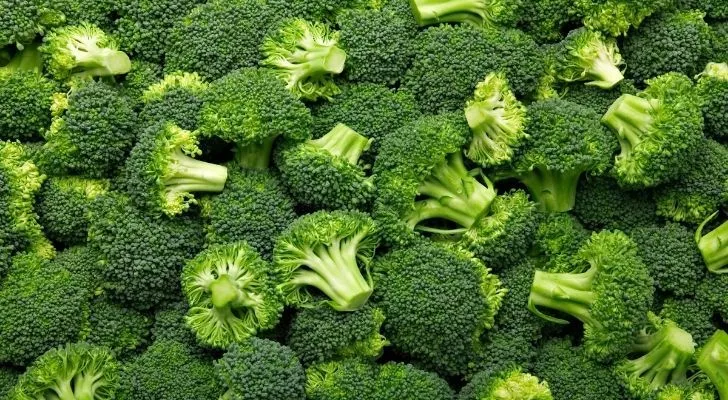
Coming from the cruciferous family of vegetables, broccoli can be found in cuisines from all over the world.
The part of the vegetable that is most commonly eaten is the flower of the plant, referred to as the head.
While some throw out the chunky stalk after detaching it from the head, it’s actually edible too – and just as nutritious!
A single cup (3.2oz/91g) of raw broccoli is absolutely bursting with nutrients, containing:
- 135% of daily required vitamin C
- 116% of daily required vitamin K
- 10% of daily required fiber, folate, manganese, and vitamin A
It’s also claimed that eating broccoli can help reduce the risk of cancer and lower the oxidants in your body!
Brussels sprouts
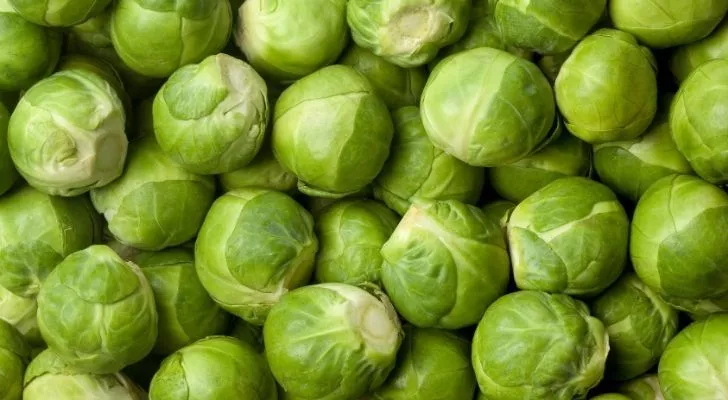
Brussels sprouts are another member of the highly beneficial cruciferous vegetable family.
This vegetable has a much more storied place on the dinner table, though.
It’s heralded by kids across the world as quite possibly the worst vegetable, yet come adulthood, they marvel at its delicious yet nutritious nature!
A single cup (3.1oz/88g) of raw Brussels sprouts packs quite a punch, containing:
- 195% of daily required vitamin K
- 125% of daily required vitamin C
- At least 10% of the daily required vitamin B6, folate, potassium, and fiber
Like broccoli, Brussels sprouts have many great health benefits. Notably, they contain an antioxidant called kaempferol.
This helps detoxify the body, and it’s also said to help prevent cell damage!
Spinach
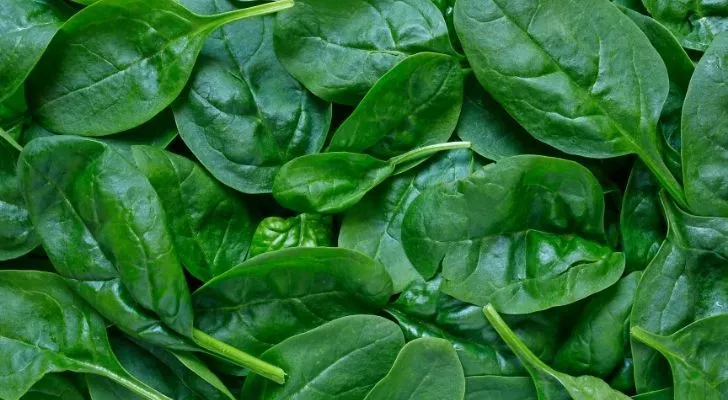
Spinach is part of a broader category of vegetables referred to simply as leafy greens.
Referred to by many as one of the healthiest vegetables you can eat, it certainly doesn’t disappoint!
Baby spinach is often eaten raw, while its adult form is most frequently cooked with other ingredients.
A single cup (1.1oz/30g) of chopped raw spinach is more than just a tasty addition to a salad, containing:
- Just 7 calories
- 56% of daily required vitamin A
- 181% of daily required vitamin K
- A healthy variety of manganese, vitamin c, and folate in small amounts.
Spinach is also rich in a wide variety of antioxidants, which help reduce the risk of chronic diseases.
Two of these antioxidants are lutein and beta-carotene, which also have ties to reducing the risk of cancer.
Kale

Another wildly popular leafy green vegetable is kale.
Kale rose to fame in the early 2010s thanks to health food trends but was quite polarizing in its reception – people either loved it or couldn’t stand the taste of it!
It’s no small surprise that kale rose to such great heights, though, when you consider its nutritional benefits.
A single cup (2.4oz/67g) of chopped raw kale has absolutely crazy amounts of nutrients, containing:
- 684% of daily required vitamin K
- 206% of daily required vitamin A
- 134% of daily required vitamin C
- 26% of daily required manganese
- A wide variety of other vitamins and minerals in good amounts, such as vitamin B6, riboflavin, copper, potassium, and calcium.
Kale can be used in various ways, but it’s most commonly used as a crucial ingredient in green smoothies.
In juice form, it’s reported to lower “bad” blood cholesterol, blood pressure, and even reduce your blood sugar levels!
Asparagus
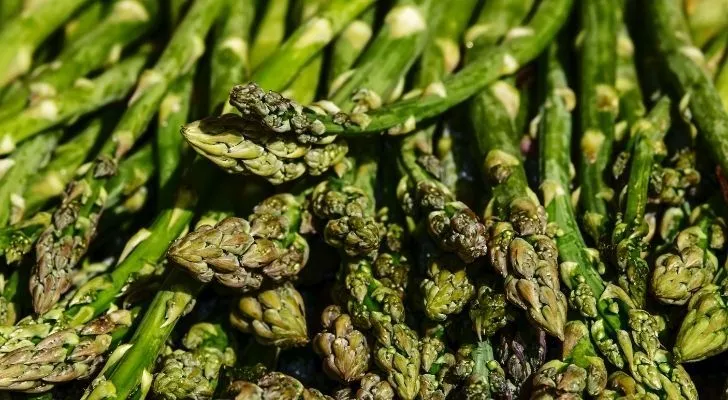
It’s green, it’s healthy, but boy does it make your pee smell funny!
Asparagus has been enjoyed for such a long time that there’s a recipe for cooking it in one of the oldest surviving cookbooks!
It’s generally enjoyed in spring, when the young shoots of asparagus are cut before they grow too large and wood-like in texture.
A single cup (4.7oz/134g) of raw asparagus has a balanced variety of nutrients, containing:
- 20% of daily required vitamin A
- 70% of daily required vitamin K
- 17% of daily required folate
- 16% of daily required iron
- 13% of daily required vitamin C, thiamine, and copper
- A wide variety of other minerals and nutrients in good levels such as fiber, vitamin E, riboflavin, phosphorous, and manganese.
Asparagus can be enjoyed in many ways, from soups to salads, to much more. One of the best ways is to keep it simple.
Sprinkle asparagus with some salt, olive oil, and a little parmesan, and roast it in the oven for a delicious yet healthy side!
Not only is asparagus delicious yet nutritious, it’s also one of just a few sources of the antioxidant glutathione, which aids the liver by binding with toxins and flushing them out of your body.
Garlic
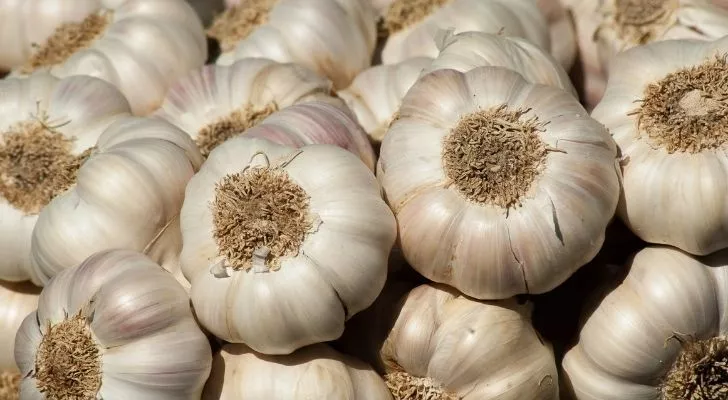
Garlic isn’t just good for keeping vampires at bay – it can play a vital role in maintaining a well-balanced diet!
It comes from the allium family, so it’s related to other shoot-like vegetables such as onions, leeks, shallots, and chives.
It’s been used in kitchens for thousands of years and as a medicine for even longer.
Its medicinal benefits have long been taken advantage of, with records of its use going back to the ancient Egyptians!
A single cup (4.8oz/136g) of raw garlic, should you ever eat this much in one day, contains:
- 114% of daily required manganese
- 84% of daily required vitamin B6
- 71% of daily required vitamin C
- 28% of daily required selenium
- Strong amounts of a healthy variety of minerals and vitamins such as calcium, phosphorous, copper, potassium, thiamine, and riboflavin.
The benefits of garlic don’t just stop with the nutrients as mentioned above – it’s also a natural antibiotic!
Garlic has also been attributed to helping reduce the risk of cancer, lowering cholesterol and blood pressure, and even reducing the risk of having a stroke.
The most effective way to gain nutrients from garlic is to eat it raw, as the longer it is cooked, the more it loses nutrients.
Carrots
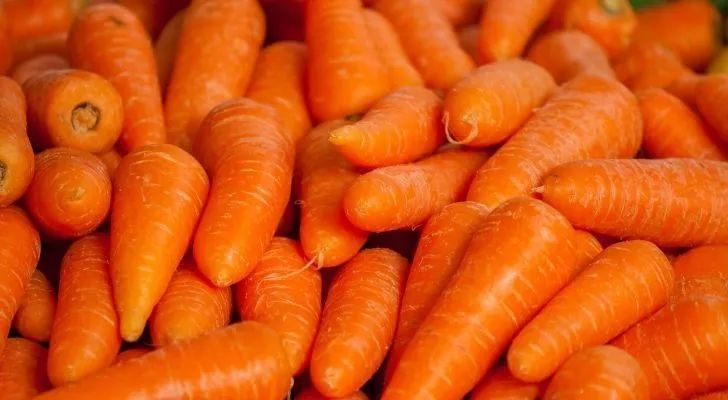
Carrots are more than just a snack for Bugs Bunny. They’ve long been touted to improve your night vision, although this isn’t entirely true.
This versatile root vegetable has been around for some time now, originating in Europe and Southwestern Asia.
A single cup (4.5oz/128g) of raw chopped carrots may not give you night vision, but it does contain:
- 428% of daily required vitamin A.
- 21% of daily required vitamin K.
- 14% of daily required fiber.
- A good range of vitamins and minerals in small doses such as vitamin C, vitamin B6, folate, potassium, and manganese.
The vitamin A you receive from carrots comes from beta-carotene, which your body then converts into vitamin A if your body requires it.
Beta-carotene is also what gives carrots their vibrant orange color.
Be careful not to eat too many carrots, though, or your skin will turn orange!
Ginger
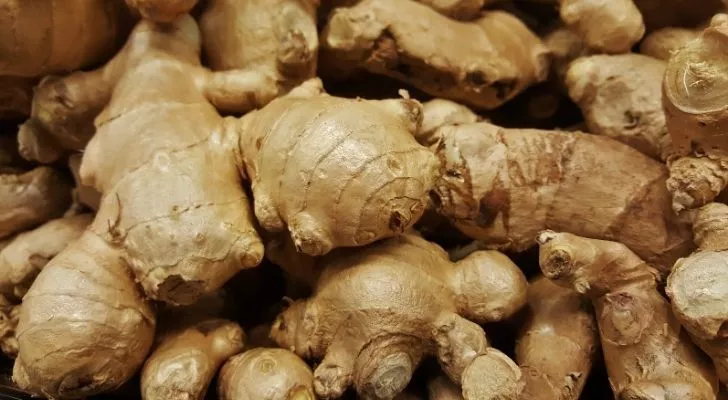
The root of the ginger plant, also called ginger, is used more as a spice than a vegetable.
It’s used in many different ways, from cookies to curries, to juices.
A single teaspoon (0.7oz/2g) of raw ginger is such a small quantity that its levels of nutrients are almost insignificant.
What ginger lacks in nutrients per serving seriously makes up for in many other ways.
It’s used as a natural remedy for motion sickness and does wonders to reduce inflammation such as arthritis or gout.
It has also been found to aid in reducing blood sugar levels when taken as a supplement by people with diabetes.
Onions
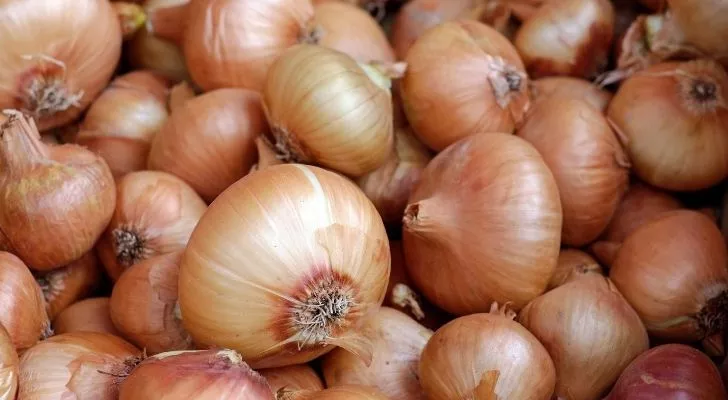
Onions can be found as a staple in larders across the world. Like garlic, they’re part of the allium family.
They are particularly dense in nutrients and have many great health benefits.
The best part about onions is how versatile they are – you can almost add them to anything, generally making it taste even better!
A single cup (5.6oz/160g) of raw onions has an excellent range of nutrients, containing:
- 11% of daily required fiber
- 20% of daily required vitamin C
- 10% of daily required vitamin B6 and manganese
- Healthy doses of folate and potassium.
It’s true that onions may not sound as impressive when you compare them to the vegetables mentioned above.
What they lack in nutrients, though, they make up in price and availability.
They’re available year-round and are always one of the cheapest vegetables you can buy.
Add the fact that they are packed full of antioxidants and have cancer-fighting properties, and they’re a wonder veg!
Green peas
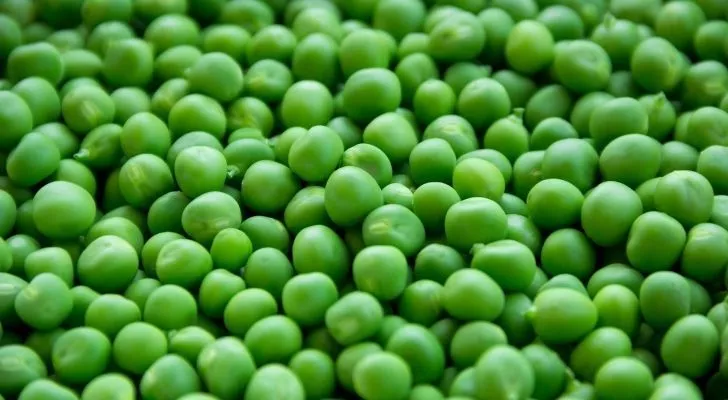
Green peas, sometimes referred to as peas, aren’t exactly vegetables.
Technically they’re legumes, just like beans, as they’re the seeds of the pea plant.
That being said, they’re more commonly eaten in the same way a vegetable would be, unlike other legumes like beans or lentils.
A single cup (5.1oz/145g) of raw peas contains:
- 16% of daily required protein
- 97% of daily required vitamin C
- 45% of daily required vitamin K
- 30% of daily required fiber and manganese
- 26% of daily required thiamine
- Strong amounts of almost all other vitamins and minerals.
Green peas are particularly great as not only are they packed full of nutrients, they’re a great source of protein too.
This is important for those on plant-based diets and people who want to reduce their overall meat consumption.
Keep in mind that there can’t ever just be one defining list of the healthiest vegetables.
This is due to the huge complexity surrounding the micro and macronutrients, as well as the many undiscovered benefits that vegetables have to offer.
There’s also the issue that different people require different diets, and as such, the ten healthiest vegetables for one person may not be the same for another.










